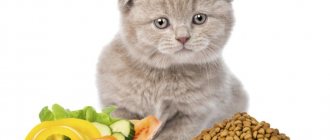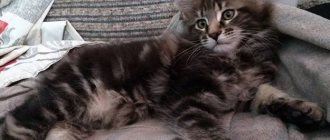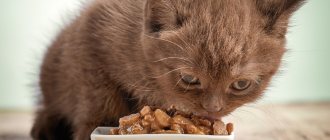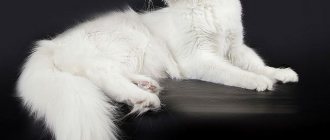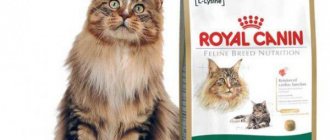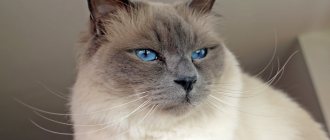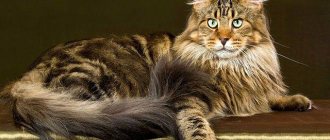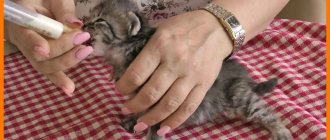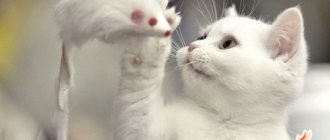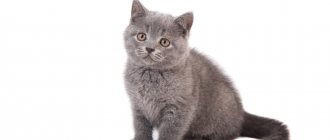Maine Coon breed
The breed was bred in the USA and received its name in connection with the associations of a raccoon; the first Maine Coons appeared in the state of Maine, which is where the name “Maine Coon” came from - maine coon - Maine Coon.
They were kept on large farms, where they guarded livestock, grain stocks and warehouses. Adult cats, unlike cats, were taken for hunting, but only those who were black tabby and fiery red in color, cats that were large and had excellent health. Their task was to scare away hidden game. The owner let the cat out under a bush, and he galloped away; as soon as the sound of the hooves died down, the cat raced through the tall grass, ears of corn, and the birds flew up into the air. Here the hunt began.
Maine Coon kittens.
Usually very young Maine Coon kittens are not given to a new family; a good breeder knows this very well that kittens cannot be separated from their mother before 3.5 – 4.5 months. Otherwise, the kids will often get sick and protest in the form of disobedience in the new family. A strong and well-built kitten at 4 months should weigh:
- Girl – 2.6-3.7 kg;
- Boy – 2.9-3.9 kg.
From 3.5 months, kittens should be able to feed themselves, be able to use the litter tray and sharpen their claws on a scratching post. Healthy babies are playful, their large and long paws, tail and muzzle are mobile. Maine Coon ears have a special distinctive feature: they are large and must have tassels at the tips, like those of a lynx, fluffy and long.
Health of raccoon kittens
Since the Maine Coon cat breed is the result of a huge cat population and a source of genetic diversity, the health of the kittens is considered to be quite strong and hardy. However, any owner should monitor the health of their pet and know the most common diseases.
Diseases
Maine Coon kittens may exhibit the following genetic diseases:
- hypertrophic cardiomyopathy
- hip dysplasia
- spinal muscular atrophy
In order not to worry about your cat in the future, choose it from responsible breeders who carefully monitor diseases and do not allow the breeding of sick animals. If you are faced with genetic defects, be sure to carry out appropriate periodic examinations in veterinary clinics so as not to worsen the situation.
Vaccinations
It is very important to get Maine Coon vaccinations on time, even if your pet is indoors and does not go outside. The first vaccination must be given to a Maine Coon kitten at 2 months, the second at 3, and then at 1 year. Afterwards the vaccination is done once a year.
You should also know that there are cases when vaccination is simply necessary, for example: mating, cat exhibition, transporting a kitten.
Teeth
Maine Coon teeth first erupt at 2 weeks, but they fully grow by 3 months. Teeth change between 3 and 7 months. First, the incisors fall off, and only then the fangs.
To ensure that your little Maine Coon has healthy and strong teeth, provide him with a balanced diet and purchase toys that will help him sharpen his teeth.
What to consider when choosing a kitten.
A real, purebred Maine Coon kitten is not cheap, and therefore it is worth taking the choice seriously, so as not to be deceived and not to buy a crossbreed, there is a lot to consider.
It is best, of course, to take a pet from professionals with documents and a contract, but even if you decide to take a kitten simply from the hands of amateurs, then you should do the following:
- Draw up a contract and print it out;
- Ask the seller to sign the contract;
- Look at the kitten's parents;
- Define metrics;
- Examine the kitten for signs of disease;
- A true Maine Coon is not shy or aggressive;
- A Maine Coon kitten at 4 months is 5 times larger than a regular kitten!
- A true purebred Maine Coon has thick, long, dense and fluffy fur;
- They have a wide, long nose with a large jaw;
- The tail of a purebred Maine Coon is always longer than the spine;
- Maine Coons are very calm, they never climb into corners, under sofas or hide.
Important: A cross with another breed will be very noticeable by 4 months, so you should not adopt a kitten earlier.
How to choose a kitten
To choose the right Maine Coon kitten, you should first study the breed standards according to the European and American versions of the systems, and also visit several exhibitions. After this, you can confidently go to the nurseries that you like.
Choosing a small Maine Coon
- If you wish, you have the right to look at the kitten’s parents and ask about their veterinary passports and pedigrees.
- If the cattery has other popular cat breeds, breeders may offer mixed breeds or crossbreeds. Of course, they can be wonderful and cute, but they will no longer be considered real Maine Coons.
- If you are offered a show class kitten with no breeding restrictions, then most likely you are again being offered a cross between two breeds.
- Pay attention to the character of the Maine Coon. He should not be intimidated or aggressive.
- You can buy a kitten only after 3 months, when the mother cat has passed on the necessary animal skills to it.
How to name a Maine Coon kitten >> How to name a purebred kitten >> How to name a kitten based on the length of its fur >>
Features of the Maine Coon breed.
Lovers of space, nature and communication, Maine Coons adore small children and will never offend them.
They quickly and strongly get used to their owners, they experience hard and painful feelings if they are given to another family, they may not eat for 5-7 days and become sad; it is not uncommon for them to run away and go in search of their former owners.
Therefore, before you decide to adopt a Maine Coon, you should think a thousand times, and if you decide, take it once and for all.
At one year old cats are already very large and can easily put any dog no larger than average in their place. They love to chase birds and are great at catching them. Don’t be surprised if you often find your Maine Coon’s prey, or rather feathers from it, on the doorsteps of your home, this is how they demonstrate their dexterity to their owners, and where else can you taste game if not at home.
Appearance
For a long time they were considered one of the largest cats. For example, the largest such cat is listed in the Guinness Book of Records with a length from the tip of its nose to the tip of its tail as much as 123 centimeters!
At 3 months, the Maine Coon's growth continues to increase. Active growth continues for up to 9 months - a year. And the full formation of animals ends only before 3-4.5 years.
We've talked about height, but now it's time to talk about how much a Maine Coon weighs. Kittens are born weighing 100-160 grams, but over time the sizes increase significantly and the male can weigh up to 10 kilograms, and the female about 5-7 kg.
© shutterstock
Outwardly, these cats resemble a lynx - they have tufts at the tips of their large ears. True, if tassels do not appear before the age of 3-3.5 months, they will no longer exist . The Maine Coon's tail is long and often striped. The body is proportional, and the eyes are slightly squinting. Cats have quite long fur, but they don't shed too much. This breed is also characterized by prominent cheekbones.
To find out what Maine Coon kittens look like, you can find a photo of a Maine Coon at 3 months in our article - and see everything with your own eyes.
Choosing a name for a kitten.
Many people find it very difficult to choose a name for a kitten, or one that is too long in the pedigree or simply doesn’t like it. It is worth paying attention that it is best to choose a name for the baby, paying attention to the external characteristics, color, and behavior of the little Maine Coon.
Important: No matter how cute and small your pet is, do not call him with very gentle, diminutive nicknames like “Muska”, “Kroshka”, “Small”. Or ridiculous nicknames - “Pig”, “Red”, “Crow”, etc. Remember that the pet will grow up, become big and will visit exhibitions, a veterinarian, matings and a beautiful, suitable name will become an adornment for a chic Maine Coon .
What standards does this pet have?
The breed has a number of inherent characteristics:
- The size of the cat is large. The body is elongated, muscular, and has a slightly rectangular shape. The chest is massive, wide, and the neck is medium, not very long.
- The ends are very strong, with good muscles, medium in size. The paws are round, large in shape, and have tufts of hair between each toe.
- The animal has a fluffy tail, which tapers at the base.
- The Maine Coon's head is predominantly massive and large.
- The ears have sharp tips, but are wide at the very base. They are placed the width of one ear, almost vertically.
- The wool is soft. Short on the head and long on the back, with a thick undercoat.
Care and health.
The Maine Coon is a large cat with thick hair, naturally the main part of caring for it is. Every day it is necessary to comb your pet, inspect the ears, behind the ears, and the armpit area; if lumps are found, they must be cut out. And if foci of baldness appear in these areas, it is necessary to urgently treat the animal for lice and exaparasites on the body. If a kitten or an adult pet shakes its ears and scratches them all the time, and there are black dots inside the ear, it means that it has mites.
Harmful and difficult to remove mites inside the ear can be transmitted from other animals or get in with dirt, or brought in from the street. First of all, you need to contact a veterinarian! Basic care for Maine Coons is practically no different from caring for any other breeds; perhaps the main difference is nutrition and an active lifestyle. For this, Maine Coons require much more than ordinary cats, because they are much larger!
Maine Coon care
Maine Coons have a regal appearance, so their care must match. It is necessary to examine the kitten from head to toe every day; make it a habit and do it regularly, every month. So where to start?
Ears
First, look at your pet's ears: everything inside should be perfectly clean. If there is any dirt, carefully remove it with a cotton swab and treat with an antiseptic.
Eyes and nose
These parts of the Maine Coon's body do not cause any discomfort. The main requirement is that there should be no dirt or oxides on them. You can treat it with a regular cloth moistened with warm water.
Oral cavity
Be sure to examine the oral cavity. At 2 months, the Main Coon kitten should have beautiful teeth and there should be no inflammation or wounds in the mouth.
Nails
Don’t ignore the Maine Coon’s claws, they grow very quickly, so much so that the cat himself does not have time to sharpen them, so you will need to do this.
Wool
Looking at a photo of a Maine Coon at two months, you will be able to notice that he has a well-groomed coat. In a healthy cat, it is fluffy, clean and silky . If you suddenly notice a mat on your pet, then try to carefully disassemble it; if this does not work, use scissors and carefully cut off the mat.
How to litter train a Maine Coon
Before bringing a kitten into the house, it is necessary to close all places where the pet can get through unnoticed. It is also better to close the doors to the rooms; in the corridor and in the bathroom it is worth laying different materials on three or four plastic trays:
- For the first, an ordinary rag (an old cotton towel, thick and well-absorbed, is perfect, not a diaper from the store!);
- Place soft, non-rusting paper on the second one (you can tear toilet paper coarsely);
- For the third, special sawdust, soft. There is such sawdust that is sold for animals kept in cages, yes, many cats love to go to the tree;
- On the fourth one, pour the usual litter for cat trays.
Arrange them all in different, but convenient for further use, corners, preferably in a more closed place. Instead of trays, you can purchase deeper and wider plastic basins, but not too high. After all, 90% of Maine Coons and Norwegian Forest cats are the largest two breeds of domestic cats in the world, they prefer to go to such a mini toilet, a proven fact!
You will have to study the pet for about a week, monitor it, and up to 1.5 years, train, train and train five times a day, but never hit!
